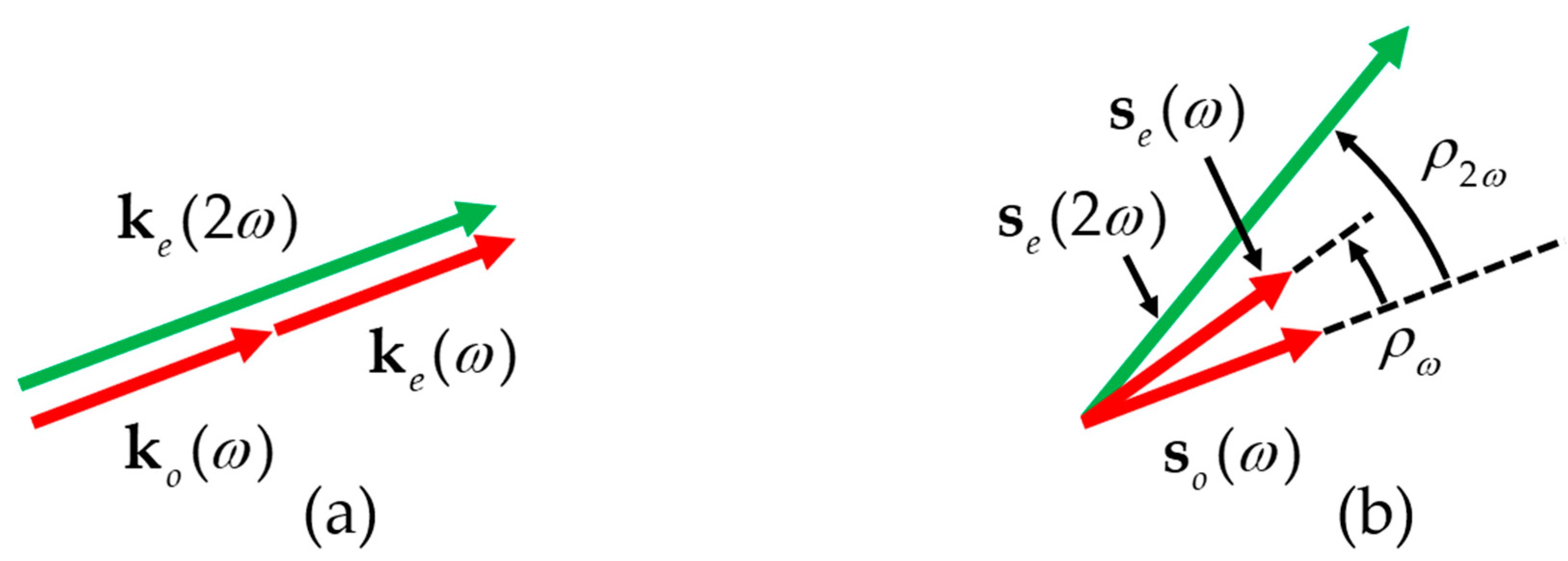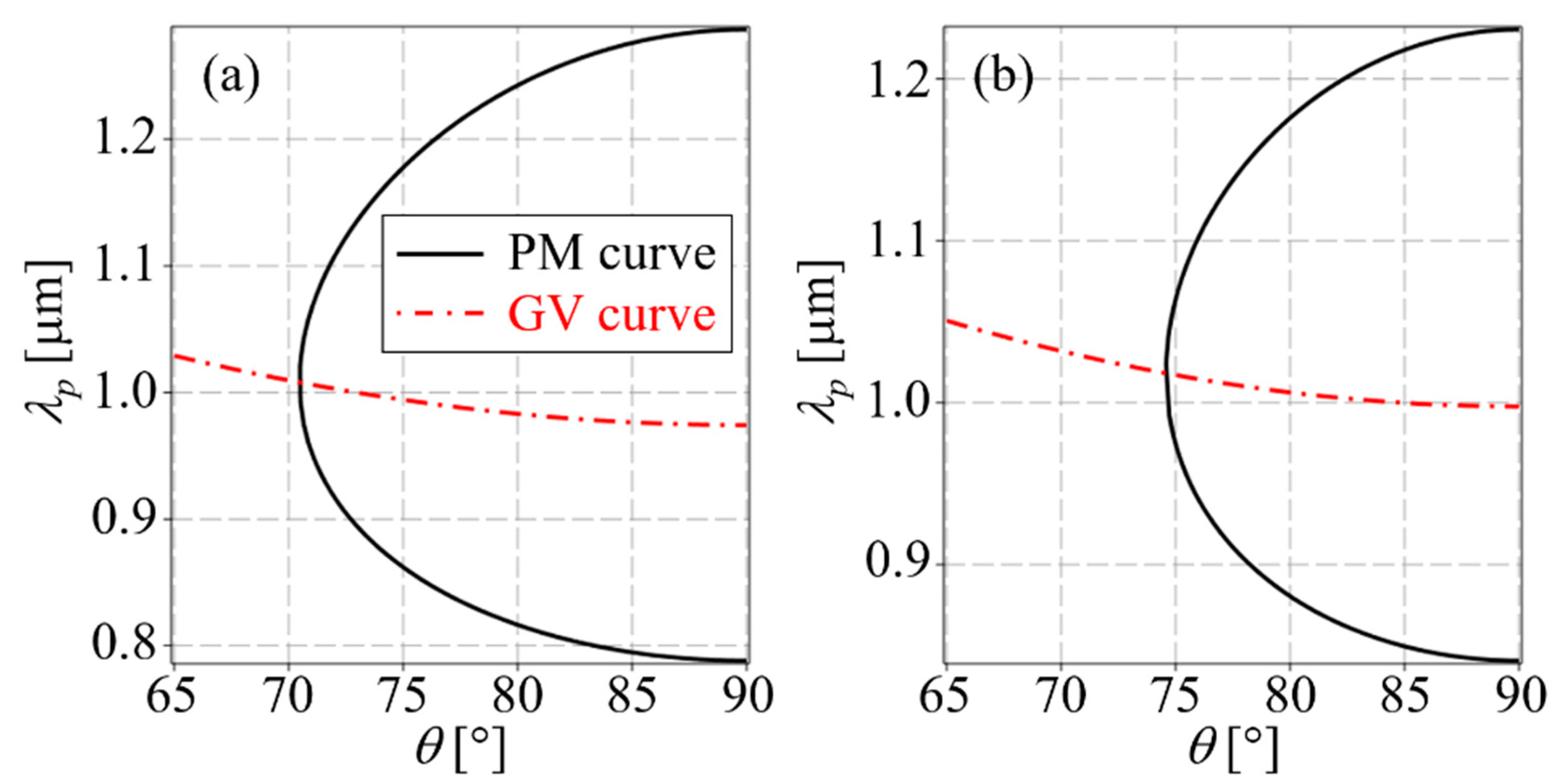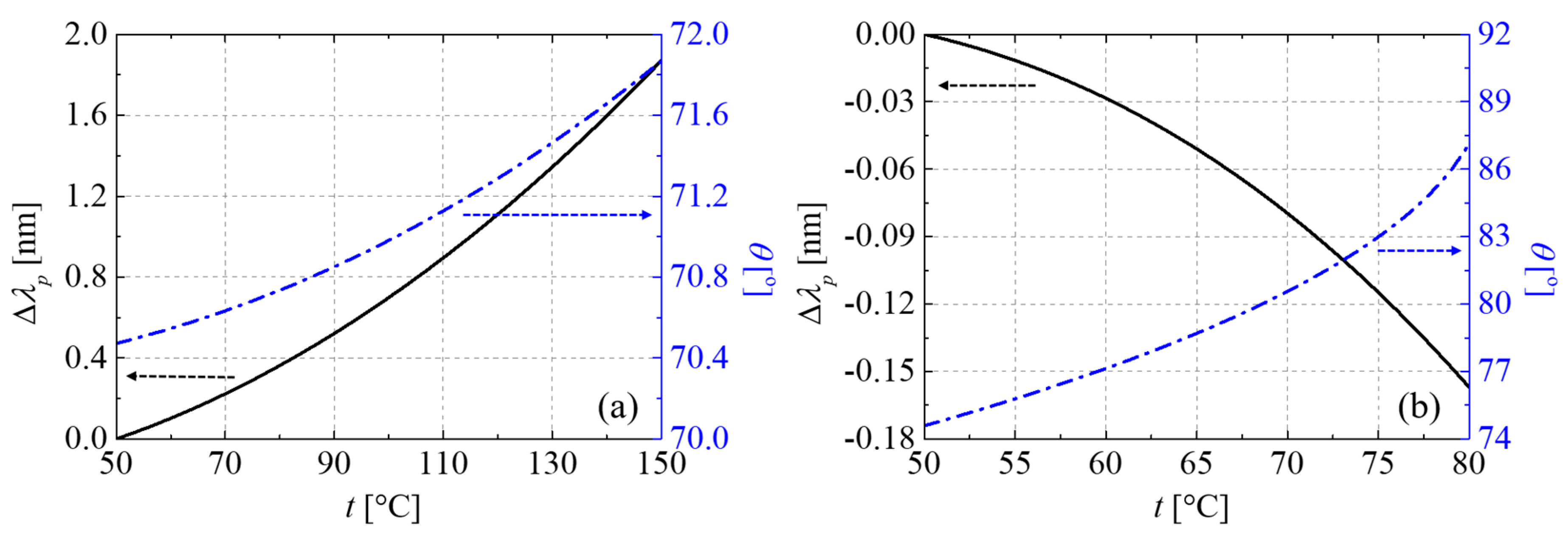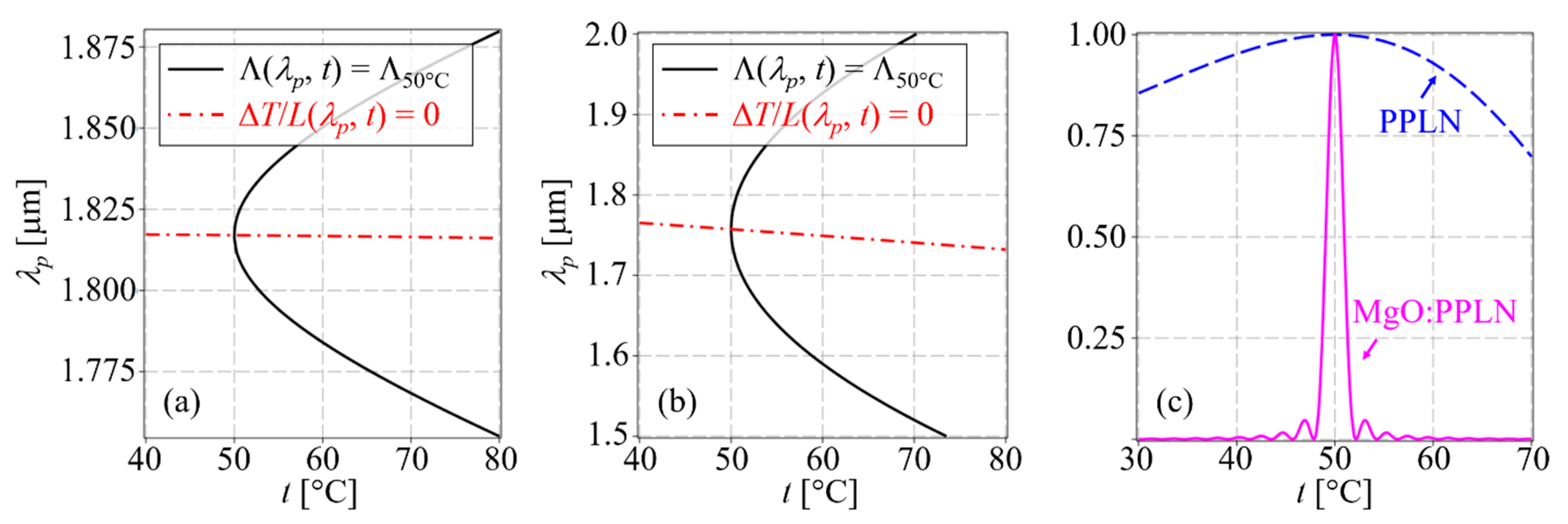Study of Type II SPDC in Lithium Niobate for High Spectral Purity Photon Pair Generation
Abstract
1. Introduction
2. Materials and Theories
3. Simulations and Discussion
4. Conclusions
Author Contributions
Funding
Institutional Review Board Statement
Informed Consent Statement
Data Availability Statement
Conflicts of Interest
References
- Volk, T.; Wöhlecke, M. Lithium Niobate; Springer: Berlin, Germany, 2008; pp. 1–7. [Google Scholar]
- Jia, Y.; Wang, L.; Chen, F. Ion-cut lithium niobate on insulator technology: Recent advances and perspectives featured. Appl. Phys. Rev. 2021, 8, 011307. [Google Scholar] [CrossRef]
- Poberaj, G.; Hu, H.; Sohler, W.; Günter, P. Lithium niobate on insulator (LNOI) for micro-photonic devices. Laser Photon. Rev. 2012, 6, 488–503. [Google Scholar] [CrossRef]
- Jinan Jingzheng Electronics Co.,Ltd. (nanoln). Available online: https://www.nanoln.com (accessed on 25 February 2021).
- Wang, C.; Zhang, M.; Chen, X.; Bertrand, M.; Shams-Ansari, A.; Chandrasekhar, S.; Winzer, P.; Lončar, M. Integrated lithium niobate electro-optic modulators operating at CMOS-compatible voltages. Nature 2018, 562, 101–104. [Google Scholar] [CrossRef] [PubMed]
- Wang, C.; Langrock, C.; Marandi, A.; Jankowski, M.; Zhang, M.; Desiatov, B.; Fejer, M.M.; Lončar, M. Ultrahigh-efficiency wavelength conversion in nanophotonic periodically poled lithium niobate waveguides. Optica 2018, 5, 1438–1441. [Google Scholar] [CrossRef]
- Wang, C.; Zhang, M.; Yu, M.; Zhu, R.; Hu, H.; Lončar, M. Monolithic lithium niobate photonic circuits for Kerr frequency comb generation and modulation. Nat. Commun. 2019, 10, 978. [Google Scholar] [CrossRef]
- Yu, M.; Wang, C.; Zhang, M.; Lončar, M. Chip-based lithium-niobate frequency combs. IEEE Photon. Technol. Lett. 2019, 31, 1894–1897. [Google Scholar] [CrossRef]
- Yu, M.; Desiatov, B.; Okawachi, Y.; Gaeta, A.L.; Lončar, M. Coherent two-octave spanning supercontinuum generation in lithium-niobate waveguides. Opt. Lett. 2019, 44, 1222–1225. [Google Scholar] [CrossRef]
- Okawachi, Y.; Yu, M.; Desiatov, B.; Kim, B.Y.; Hansson, T.; Lončar, M.; Gaeta, A.L. Chip-based self-referencing using integrated lithium niobate waveguides. Optica 2020, 7, 702–707. [Google Scholar] [CrossRef]
- Pohl, D.; Reig Escalé, M.; Madi, M.; Kaufmann, F.; Brotzer, P.; Sergeyev, A.; Guldimann, B.; Giaccari, P.; Alberti, E.; Meier, U.; et al. An integrated broadband spectrometer on thin-film lithium niobate. Nat. Photonics 2020, 14, 24–29. [Google Scholar] [CrossRef]
- Xu, M.; He, M.; Zhang, H.; Jian, J.; Pan, Y.; Liu, X.; Chen, L.; Meng, X.; Chen, H.; Li, Z.; et al. High-performance coherent optical modulators based on thin-film lithium niobate platform. Nat. Commun. 2020, 11, 3911. [Google Scholar] [CrossRef]
- Desiatov, B.; Shams-Ansari, A.; Zhang, M.; Wang, C.; Lončar, M. Ultra-low loss integrated visible photonics using thin-film lithium niobite. Optica 2019, 6, 380–384. [Google Scholar] [CrossRef]
- Holzgrafe, J.; Sinclair, N.; Zhu, D.; Shams-Ansari, A.; Colangelo, M.; Hu, Y.; Zhang, M.; Berggren, K.K.; Lončar, M. Cavity electro-optics in thin-film lithium niobate for efficient microwave-to-optical transduction. Optica 2020, 7, 1714–1720. [Google Scholar] [CrossRef]
- Luke, K.; Kharel, P.; Reimer, C.; He, L.; Loncar, M.; Zhang, M. Wafer-scale low-loss lithium niobate photonic integrated circuits. Opt. Express 2020, 28, 24452–24458. [Google Scholar] [CrossRef] [PubMed]
- Shao, L.; Sinclair, N.; Leatham, J.; Hu, Y.; Yu, M.; Turpin, T.; Crowe, D.; Lončar, M. Integrated microwave acousto-optic frequency shifter on thin-film lithium niobate. Opt. Express 2020, 28, 23728–23738. [Google Scholar] [CrossRef]
- Jankowski, M.; Langrock, C.; Desiatov, B.; Marandi, A.; Wang, C.; Zhang, M.; Phillips, C.R.; Lončar, M.; Fejer, M.M. Ultrabroadband nonlinear optics in nanophotonic periodically poled lithium niobate waveguides. Optica 2020, 7, 40–46. [Google Scholar] [CrossRef]
- Boyd, R.W. Nonlinear Optics, 4th ed.; Academic Press: San Diego, CA, USA, 2020; pp. 77–79. [Google Scholar]
- Kwiat, P.; Mattle, K.; Weinfurter, H.; Zeilinger, A.; Sergienko, A.V.; Shih, Y. New high-intensity source of polarization-entangled photon pairs. Phys. Rev. Lett. 1995, 75, 4337–4341. [Google Scholar] [CrossRef] [PubMed]
- Steinlechner, F.; Gilaberte, M.; Jofre, M.; Scheidl, T.; Torres, J.P.; Pruneri, V.; Ursin, R. Efficient heralding of polarization-entangled photons from type-0 and type-II spontaneous parametric downconversion in periodically poled KTiOPO4. J. Opt. Soc. Am. B 2014, 31, 2068–2076. [Google Scholar] [CrossRef]
- Giovannetti, V.; Maccone, L.; Shapiro, J.H.; Wong, F.N.C. Extended phase-matching conditions for improved entanglement generation. Phys. Rev. A 2002, 66, 043813. [Google Scholar] [CrossRef]
- Jin, R.-B.; Shimizu, R.; Wakui, K.; Fujiwara, M.; Yamashita, T.; Miki, S.; Terai, H.; Wang, Z.; Sasaki, M. Pulsed Sagnac polarization-entangled photon source with a PPKTP crystal at telecom wavelength. Opt. Express 2014, 22, 11498–11507. [Google Scholar] [CrossRef]
- Li, Y.; Zhou, Z.-Y.; Ding, D.-S.; Shi, B.-S. CW-pumped telecom band polarization entangled photon pair generation in a Sagnac interferometer. Opt. Express 2015, 23, 28792–28800. [Google Scholar] [CrossRef]
- Weston, M.M.; Chrzanowski, H.M.; Wollmann, S.; Boston, A.; Ho, J.; Shalm, L.K.; Verma, V.B.; Allman, M.S.; Nam, S.W.; Patel, R.B.; et al. Efficient and pure femtosecond-pulse-length source of polarization-entangled photons. Opt. Express 2016, 24, 10869–10879. [Google Scholar] [CrossRef] [PubMed]
- Kim, I.; Lee, D.; Lee, K.J. Numerical investigation of high-purity polarization-entangled photon-pair generation in non-poled KTP Isomorphs. Appl. Sci. 2021, 11, 565. [Google Scholar] [CrossRef]
- Fujii, G.; Namekata, N.; Motoya, M.; Kurimura, S.; Inoue, S. Bright narrowband source of photon pairs at optical telecommunication wavelengths using a type-II periodically poled lithium niobate waveguide. Opt. Express 2007, 15, 12769–12776. [Google Scholar] [CrossRef] [PubMed]
- Martin, A.; Issautier, A.; Herrmann, H.; Sohler, W.; Ostrowsky, D.B.; Alibart, O.; Tanzilli, S. A polarization entangled photon-pair source based on a type-II PPLN waveguide emitting at a telecom wavelength. New. J. Phys. 2010, 12, 103005. [Google Scholar] [CrossRef]
- Cheng, X.; Sarihan, M.C.; Chang, K.-C.; Lee, Y.S.; Laudenbach, F.; Ye, H.; Yu, Z.; Wong, C.W. Design of spontaneous parametric down-conversion in integrated hybrid SixNy-PPLN waveguides. Opt. Express 2019, 27, 30773–30787. [Google Scholar] [CrossRef]
- Kuo, P.S.; Verma, V.B.; Nam, S.W. Demonstration of a polarization-entangled photon-pair source based on phase-modulated PPLN. OSA Continuum 2020, 3, 295–304. [Google Scholar] [CrossRef]
- Kuo, P.S.; Gerrits, T.; Verma, V.; Nam, S.W.; Slattery, O.; Ma, L.; Tang, X. Characterization of type-II spontaneous parametric down-conversion in domain-engineered PPLN. In Proceedings of the SPIE Advances in Photonics of Quantum Computing Memory, and Communication IX, San Francisco, CA, USA, 13–18 February 2016; SPIE: Bellingham, WA, USA, 2016. [Google Scholar]
- Zhao, J.; Ma, C.; Rüsing, M.; Mookherjea, S. High quality entangled photon pair generation in periodically poled thin-film lithium niobate waveguides. Phys. Rev. Lett. 2020, 124, 163603. [Google Scholar] [CrossRef]
- Chen, J.-Y.; Sua, Y.M.; Ma, Z.-H.; Tang, C.; Li, Z.; Huang, Y.-P. Efficient parametric frequency conversion in lithium niobate nanophotonic chips. OSA Continuum 2019, 2, 2914–2924. [Google Scholar] [CrossRef]
- Schlarb, U.; Betzler, K. ‘Influence of the defect structure on the refractive indices of undoped and Mg-doped lithium niobate. Phys. Rev. B 1994, 50, 751. [Google Scholar] [CrossRef]
- Zelmon, D.E.; Small, D.L.; Jundt, D. Infrared corrected Sellmeier coefficients for congruently grown lithium niobate and 5 mol. % magnesium oxide–doped lithium niobate. J. Opt. Soc. Am. B 1997, 14, 3319–3322. [Google Scholar] [CrossRef]
- Prabhakar, S.; Shields, T.; Dada, A.C.; Ebrahim, M.; Taylor, G.G.; Morozov, D.; Erotokritou, K.; Miki, S.; Yabuno, M.; Terai, H.; et al. Two-photon quantum interference and entanglement at 2.1 μm. Sci. Adv. 2020, 6, eaay5195. [Google Scholar] [CrossRef]
- Rosenfeld, L.M.; Sulway, D.A.; Sinclair, G.F.; Anant, V.; Thompson, M.G.; Rarity, J.G.; Silverstone, J.W. Mid-infrared quantum optics in silicon. Opt. Express 2020, 28, 37092–37102. [Google Scholar] [CrossRef] [PubMed]
- Mancinelli, M.; Trenti, A.; Piccione, S.; Fontana, G.; Dam, J.S.; Tidemand-Lichtenberg, P.; Pedersen, C.; Pavesi, L. Mid-infrared coincidence measurements on twin photons at room temperature. Nat. Commun. 2017, 8, 15184. [Google Scholar] [CrossRef]
- Sua, Y.M.; Fan, H.; Shahverdi, A.; Chen, J.Y.; Huang, Y.P. Direct generation and detection of quantum correlated photons with 3.2 μm wavelength spacing. Sci. Rep. 2017, 7, 17494. [Google Scholar] [CrossRef]
- Edwards, G.J.; Lawrence, M. A temperature-dependent dispersion equation for congruently grown lithium niobate. Opt. Quant. Electron. 1984, 16, 373–375. [Google Scholar] [CrossRef]
- Gayer, O.; Sacks, Z.; Galun, E.; Arie, A. Temperature and wavelength dependent refractive index equations for MgO-doped congruent and stoichiometric LiNbO3. Appl. Phys. B 2008, 91, 343–348. [Google Scholar] [CrossRef]
- Lee, K.J.; Lee, S.; Shin, H. Extended phase matching properties of periodically poled potassium niobate crystals for mid-infrared polarization-entangled photon-pair generation. Appl. Opt. 2016, 55, 9791–9796. [Google Scholar] [CrossRef] [PubMed]
- Shoji, I.; Nakamura, H.; Ohdaira, K.; Kondo, T.; Ito, R.; Okamoto, T.; Tatsuki, K.; Kubota, S. Absolute measurement of second-order nonlinear-optical coefficients of β-BaB2O4 for visible to ultraviolet second-harmonic wavelengths. J. Opt. Soc. Am. B 1999, 16, 620–624. [Google Scholar] [CrossRef]
- Miller, R.C.; Nordland, W.A.; Bridenbaugh, P.M. Dependence of second-harmonic-generation coefficients of LiNbO3 on melt composition. J. Appl. Phys. 1971, 42, 4145–4147. [Google Scholar] [CrossRef]
- Roberts, D.A. Simplified characterization of uniaxial and biaxial nonlinear optical crystals: A plea for standardization of nomenclature and conventions. IEEE J. Quant. Electron. 1992, 28, 2057–2074. [Google Scholar] [CrossRef]
- Gehr, R.J.; Kimmel, M.W.; Smith, A.V. Simultaneous spatial and temporal walk-off compensation in frequency-doubling femtosecond pulses in β-BaB2O4. Opt. Lett. 1998, 23, 1298–1300. [Google Scholar] [CrossRef]
- Shoji, I.; Kondo, T.; Kitamoto, A.; Shirane, M.; Ito, R. Absolute scale of second-order nonlinear-optical coefficients. J. Opt. Soc. Am. B 1997, 14, 2268–2294. [Google Scholar] [CrossRef]
- Grice, W.P.; Walmsley, I.A. Spectral information and distinguishability in type-II down-conversion with a broadband pump. Phys. Rev. A 1997, 56, 1627. [Google Scholar] [CrossRef]
- Law, C.K.; Walmsley, I.A.; Eberly, J.H. Continuous frequency entanglement: Effective finite Hilbert space and entropy control. Phys. Rev. Lett. 2000, 84, 5304. [Google Scholar] [CrossRef] [PubMed]
- Mosley, P.J.; Lundeen, J.S.; Smith, B.J.; Walmsley, I.A. Conditional preparation of single photons using parametric downconversion: A recipe for purity. New. J. Phys. 2008, 10, 093011. [Google Scholar] [CrossRef]
- Nanoplus GmbH. Available online: https://nanoplus.com/en/products/fabry-perot-lasers-fp/1700-nm-2400-nm (accessed on 31 March 2021).
- Nanoplus GmbH. Available online: https://nanoplus.com/en/products/distributed-feedback-lasers-dfb/1650-nm-1850-nm (accessed on 31 March 2021).
- Nanoplus GmbH. Available online: https://nanoplus.com/en/products/superluminescent-diodes-sld/1700-nm-2300-nm (accessed on 31 March 2021).
- Nanoplus GmbH. Available online: https://nanoplus.com/en/applications/applications-by-gas (accessed on 15 February 2021).
- Whittaker, R.; Erven, C.; Neville, A.; Berry, M.; O’Brien, J.L.; Cable, H.; Matthews, J.C.F. Absorption spectroscopy at the ultimate quantum limit from single-photon states. New J. Phys. 2017, 19, 023013. [Google Scholar] [CrossRef]
- Thorlabs Inc. Available online: https://www.thorlabs.com/thorproduct.cfm?partnumber=SM2000 (accessed on 25 February 2021).
- Iqbal, M.A.; Krzeczunowicz, L.; Phillips, I.; Harper, P.; Forysiak, W. Evaluation of performance penalty from pump-signal overlap in S+C+L band discrete Raman amplifiers. In Proceedings of the Optical Fiber Communication Conference (OFC), San Diego, CA, USA, 8–12 March 2020. [Google Scholar]
- Hamaoka, F.; Nakamura, M.; Okamoto, S.; Minoguchi, K.; Sasai, T.; Matsushita, A.; Yamazaki, E.; Kisaka, Y. Ultra-wideband WDM transmission in S-, C-, and L-bands using signal power optimization scheme. J. Lightwave Technol. 2019, 37, 1764. [Google Scholar] [CrossRef]









| Crystal | |d15| [pm/V] 1 | Λ [μm] | λp [nm] | λs,i [nm] |
|---|---|---|---|---|
| PPLN | 4.35 ± 0.44 [43,44] | 18.04 | 1817.03 | 3634.06 |
| 5-mol% MgO:PPLN | 4.4 [46] | 18.35 | 1757.35 | 3514.70 |
| Crystal | θ [°] | λp [nm] | λs,i [nm] | deff [pm/V] | w [°] | Δ [μm/mm] |
|---|---|---|---|---|---|---|
| LN | 70.47 | 1007.99 | 2015.99 | 0.21 | 1.30 | 22.73 |
| 5-mol% MgO:LN | 74.58 | 1018.15 | 2036.30 | 0.13 | 1.01 | 17.60 |
Publisher’s Note: MDPI stays neutral with regard to jurisdictional claims in published maps and institutional affiliations. |
© 2021 by the authors. Licensee MDPI, Basel, Switzerland. This article is an open access article distributed under the terms and conditions of the Creative Commons Attribution (CC BY) license (https://creativecommons.org/licenses/by/4.0/).
Share and Cite
Kim, I.; Lee, D.; Lee, K.J. Study of Type II SPDC in Lithium Niobate for High Spectral Purity Photon Pair Generation. Crystals 2021, 11, 406. https://doi.org/10.3390/cryst11040406
Kim I, Lee D, Lee KJ. Study of Type II SPDC in Lithium Niobate for High Spectral Purity Photon Pair Generation. Crystals. 2021; 11(4):406. https://doi.org/10.3390/cryst11040406
Chicago/Turabian StyleKim, Ilhwan, Donghwa Lee, and Kwang Jo Lee. 2021. "Study of Type II SPDC in Lithium Niobate for High Spectral Purity Photon Pair Generation" Crystals 11, no. 4: 406. https://doi.org/10.3390/cryst11040406
APA StyleKim, I., Lee, D., & Lee, K. J. (2021). Study of Type II SPDC in Lithium Niobate for High Spectral Purity Photon Pair Generation. Crystals, 11(4), 406. https://doi.org/10.3390/cryst11040406






